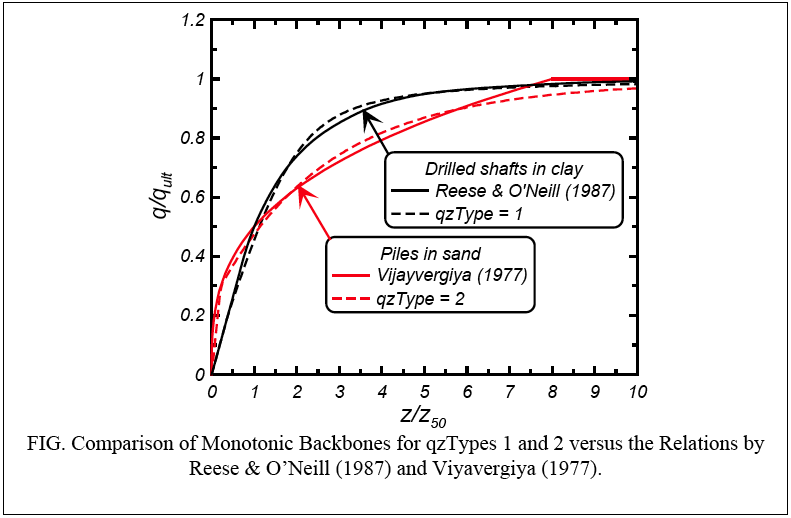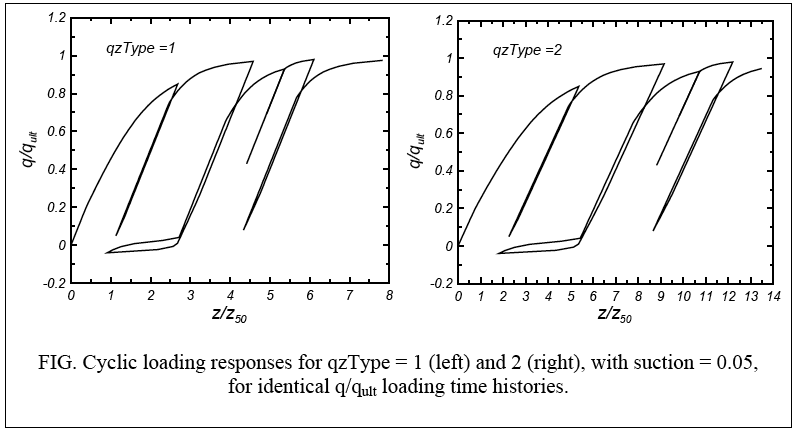QzSimple1
This command is used to construct a QzSimple1 uniaxial
material.
Model.uniaxial(“QzSimple1”, name, qzType, qult, Z50)
| qzType |
str
|
| ||||
| qult |
float
|
Ultimate capacity of the \(q-z\) material. SEE NOTE 1. | ||||
| Z50 |
float
|
Displacement at which 50% of qult is mobilized in monotonic loading. SEE NOTE 2. | ||||
| suction |
float
|
Uplift resistance is equal to suctionqult. Default = 0.0. The value of suction must be 0.0 to 0.1. | ||||
| c |
float
|
The viscous damping term (dashpot) on the far-field (elastic) component of the displacement rate (velocity). Default = 0.0. Nonzero c values are used to represent radiation damping effects.* |
NOTES:
-
qult: Ultimate capacity of the \(q\)-\(z\) material. Note that “q” or “qult” are stresses [force per unit area of pile tip] in common design equations, but are both loads for this uniaxialMaterial [i.e., stress times tip area]. -
Y50: Displacement at which 50% of pult is mobilized in monotonic loading. Note that Vijayvergiya’s relation (qzType=2) refers to a “critical” displacement (zcrit) at which qult is fully mobilized, and that the correspondingz50would be 0. 125zcrit. - optional args $suction and $c must either both be omitted or both provided.
EQUATIONS and EXAMPLE RESPONSES:
The equations describing QzSimple1 behavior are similar
to those for \(p\)-\(y\) materials by Boulanger, R. W., Curras,
C. J., Kutter, B. L., Wilson, D. W., and Abghari, A. (1999). “Seismic
soil-pile-structure interaction experiments and analyses.” Journal of
Geotechnical and Geoenvironmental Engineering, ASCE, 125(9):
750-759.
Modifications were required for representing the different responses of a \(q-z\) material in compression versus uplift.
The nonlinear \(q\)-\(z\) behavior is conceptualized as consisting of elastic (\(q\)- \(z^e\) ), plastic \(z^e\) ) \(z^e\) ) (\(q\)-\(z^p\)), and gap (\(q-z^g\)) components in series. Radiation damping is modeled by a dashpot on the “far-field” elastic component ( \(q-z^e\) ) of the displacement rate. The gap component consists of a bilinear closure spring ( \(q^c-z^g\) ) in parallel with a nonlinear drag \(q^c-z^g\) ) spring (\(q^d-z^g\)). Note that \(z = z^e + z^p + z^g\) , and that \(q = q^d + q^c\) .
The plastic component has an initial range of rigid behavior between
\[-C_r q_\text{ult} < q < C_r q_\text{ult}\]
with \(C_r\) = the ratio of \(\frac{q}{q_{\text{ult}}}\) when plastic yielding first occurs in virgin loading. The rigid range of \(q\), which is initially \(2 C_r q_\text{ult}\) , translates and grows with plastic yielding. The rigid range of \(q\) is constrained to a maximum size of \(0.7q_{\text{ult}}\). Beyond the rigid range, loading of the plastic ( \(q-z^p\) ) component is described by:\[q = q_{\text{ult}} - (q_{\text{ult}} - q_0) \left [\frac{c * z_{50}}{c * z_{50} + | z_p - z^p_0|} \right ]\]
where \(q_\textrm{ult}\) = the ultimate resistance of the \(q-z\) material in the current loading direction, \(q_o = q\) at the start of the current plastic loading cycle, p \(z^p_o = z^p\) at the start of the current plastic loading cycle, and c and n are constants that control the shape of \(q-z^p\) curve.
The closure ( \(q^c-z^g\) ) component is simply a bilinear elastic spring, which is relatively rigid in compression and extremely flexible in tension (uplift).
The nonlinear drag ( \(q^d-z^g\) ) component is used to allow thethe specification of some minimum “suction” on the pile tip during uplift. It is described by:
\[q^d = C_d q_\text{ult} - (C_d q_{\text{ult}} - q^d_0) \left [\frac{z_{50}}{z_{50} + 2| z^g - z^g_0|} \right ] \]
where \(C_d\) = ratio of the maximum drag (suction) force to the ultimate resistance of the \(q-z\) material, \(q^d_o = q^d\) at the start of the current loading cycle, and \(z^g_o = z^g\) at the start of the current loading cycle.
The flexibility of the above equations can be used to approximate different q-z backbone relations. Reese and O’Neill’s (1987) recommended backbone for drilled shafts in clay is closely approximated using \(c = 0.35\), \(n = 1.2\), and \(C_r = 0.2\) . Vijayvergiya’s (1977) recommended backbone for piles in sand is closely approximated using \(c = 12.3\), \(n = 5.5\), and \(C_r = 0.3\) .
QzSimple1 is currently implemented to allow use of these
two default sets of values. Values of \(q_\text{ult}\), \(z_50\) , and suction (i.e., \(C_d\) ) must then be specified to define
the \(q-z\) material behavior.
Examples of the monotonic backbones and cyclic loading response of QzSimple1 are given in the following plots.


Examples
References
“Seismic Soil-pile-strcture interaction experiments and analysis”, Boulanger, R.W., Curras, C.J., Kutter, B.L., Wilson, D.W., and Abghari, A. (1990). Jornal of Geotechnical and Geoenvironmental Engineering, ASCS, 125(9):750-759.
Code Developed by: Ross Boulanger, UC Davis